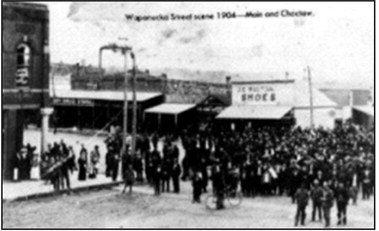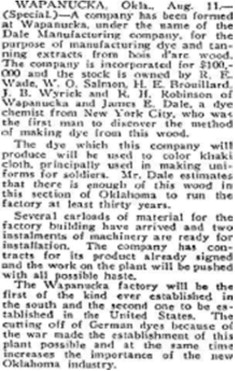It is just an intersection. The meeting of highway 48 and 7 is marked by four stop signs. The signs are unassuming to a normal passerby, but the locals know that the signs are set further than normal away from the road.
The reason for this change being that Johnston County was tired of resetting the signs every week because the frack drivers coming from Coalgate would take the turn too sharply.
It was the little things, like knowing that Dollar Bills, a white and green dilapidated building surrounded by weeds, sold the best fried chicken, but closed several years ago due to a death in the family. The Miller familyowns prominent businesses in town, a gas station, propane company, and storage buildings.
The Millers are the only reason, besides the school, that this little town has not dried up yet. Wapanucka, Oklahoma was not always the dip in the road that it became. Decades ago, the railroad still ran by the town and with it farmers were able to sell peanuts and cotton.
The Missouri, Oklahoma and Gulf Railway crossed with the CO&G railways just outside of Wapanucka. The railroads brought businesses to the town, in 1911 it had two banks, a newspaper, the Wapanucka Press, a hotel, five general stores, a blacksmith, a dentist, two doctors, a livery, two cotton gins, the Indian Territory Cotton Products Company.
The Dale Manufacturing Company, located in Wapanucka, was the first textile company to use bois d'arc trees to make dye. The dye and tanning process was urgently needed during WWI when dye importation from Germany ended.
1920 was the year that Wapanucka had its largest population, 1,038. By 1975, the majority of businesses in Wapanucka had closed. The owners either moved or passed away, unable to keep the town going. The few businesses that still open, a gas station and petroleum company were owned by Jim Miller, who still operates them to this day. The other gas station closed in 2011.
By 1938, CO&G abandoned the rail-line that ran through Wapanucka and the town began to decline. The rock quarry and cotton gins kept the town going, but eventually they closed as well; leaving only a few businesses and gas stations to keep it on the map.
According to the Oklahoma Census, in 2010 the town dipped to only 438 people living within its limits, 224 of these were children enrolled in the local school. Between the 1940’s and the early 2000’s there is little to no information about Wapanucka except for a few mentionings in the Oklahoman.
In 1982, the town was forced to file bankruptcy. This drawback led to cuts in city management. The booming little textile driven town began to wither after the Depression.
However-- a resident of Wapanucka, 69-year-old Shirley Taylor, was able to give an insight into what life was like during the 50’s and 60’s and what a hopping spot the small town was for locals.
Mrs. Taylor lived in the neighboring town of Atoka, but her beau and future husband Alton grew up just outside of Wapanucka. “Wapy was the place to go,” Shirley recounted, locals call the town by this shortened version of its name. “It had a movie theater where we would watch a show after getting ice cream at the Frosty Dip.” Sadly, there are no pictures of the ice cream parlor, movie theater, doctor's office, skating rink, hardware store, clothing store, feed store, laundry mat, or numerous bars, cafes, and gas stations that dotted Main St. and Choctow Ave.
When shown pictures of the few buildings left, Mrs. Taylor was able to point out where each business once was. She fondly remembers “dragging” Main with her husband and friends.
The tiny womanwith a dyed beehive giggles as she tellsthe story of going to the Longhorn gas station to get drunk with the owner who made his own wine. Having lived by this town for 65 years of her life, Shirley has watched it slowly fade away.
This story was written in 2018. Shirley Taylor is my grandmother, a widow for 10 years, and just celebrated her 76th birthday. A few things have changed in Wapanucka since then. The Millers no longer operate the gas station, but they still provide propane to the area. There is now a Dollar General, Saturday flea market, and a Mexican restaurant.
I have lived in this area for the majority of my life. It always felt so small, suffocating even, and I could not wait to leave it all behind. There was just something about thosequiet streets and clay brick skeletons that tugged at my heart.
I did not last long, no matter where or how far I moved away, Wapanucka was always home. There were no movie theaters, skating rinks, or arcades when I grew up in this town. Just a silent highway, two gas stations, a bank, a post office, and a broken car wash where high school kids either park their vehicles to loiter or ride skateboards.
The sections of its rural areas are a patchwork of dirt roads and asphalt freckled with potholes. It's a sleepy town with its share of scandal, but nothing that would reach the ears of an outsider.
Wapanucka may eventually be nothing more than the intersection of Highways 48 and 7; four stop signs that are set oddly and further away than they should be. By that time no one will remember why the signs are that way. The crumbling buildings that line Choctaw Ave and the ones already torn down will just become colored brick dust.
A haze of highways, lined by dirt roads and unkempt grass hides the gem of Wapanucka’s historical contribution. The lack of appeal hides a lotof things about Wapanucka, but it’s important to keep what little is known about its history alive and continuing to be passed on to the future generations, even if those generations do not stay. Wapy will always be my home, brick skeletons and all.



